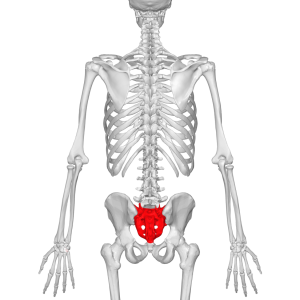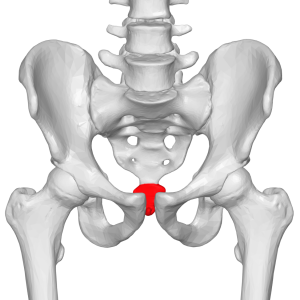Spine Anatomy Part 5 – The Sacrum and Coccyx
The areas of the sacrum and coccyx are the focus for this article on the spinal anatomy.
In our series on the anatomy of the spine we started at the top, focusing on the cervical, thoracic and then lumbar region of the spine. Directly below the last lumbar vertebrae, L5, is the sacrum and coccyx.
The Anatomy of the Spine
- Vertebrae Anatomy
- Cervical Anatomy
- Thoracic Spine
- Lumbar Spine Anatomy
- Sacrum and Coccyx
- The Spine as a Whole
The Sacrum
Sacral Region

Source: By BodyParts3D is made by DBCLS via Wikimedia Commons
The pelvic cavity is the area of the body inside the pelvic bones. The reproductive organs, urinary bladder, colon and rectum all reside within the pelvic cavity.
The sacral region is located in the upper middle portion of the pelvic cavity.
Sacral Vertebrae
The sacral region of the spine is composed of 5 vertebrae in youth, S1-S5. Somewhere around the age of 18-30 these five vertebrae fuse together to form one bone, referred to as the sacrum.
While other mammals may also have a sacrum, they are different than those of humans. For example, the sacrum of a dog is formed from the fusion of three sacral vertebrae, not five as in humans.
Sacral Joint
There are four bones that meet up with the sacrum to form joints.
- One joint is between the last lumbar vertebrae, L5, and the sacrum.
- Another joint is formed just below the sacrum where it meets the lowest portion of the spinal column, the coccyx, or tailbone.
- The other two joints are on the left and right of the sacrum where it meets the iliac portion of the hip bone. These joints are called the sacroiliac joints.
Sacroiliac Joint
You may have heard of the sacroiliac joint (SI joint) as it can often be the cause of lower back pain.
SI Joint Pain in Women
There are several strong ligaments that keep the bones together in the SI joint. During a portion of women’s menstrual cycle, certain hormones are released which cause connective tissues to relax, to prepare for childbirth. This relaxation over time may allow for excess movement in the SI joint. This is thought to be the source of the lower back pain some women experience during their menstrual cycle and childbirth.
Studies have been done on the subject of changes in the SI joint in women and men as they age but more work is needed to understand this fully.
Sacral Hiatus and Epidurals
At the bottom of the sacrum is a gap called the sacral hiatus. This gap allows for access to the spinal canal, the space inside the vertebrae which houses the spinal cord.
The sacral hiatus is commonly used by anesthesiologists to administer analgesics. This procedure is called caudal epidural block and is commonly known as an “epidural”.
Though this process for administering analgesics is commonly associated with women in childbirth, the process is also used for pain management in adults and children.
Coccyx

Source: By BodyParts3D is made by DBCLS via Wikimedia Commons
Sitting just below the sacrum is the coccyx bone, also known as the tailbone. Similar to the sacrum, the coccyx bone may be several vertebrae fused together. However, this is not always the case.
As we discussed in our article on the lumbar region, there is significant variation in the the anatomy of the coccyx. While it is typically made up of three to five vertebrae, these vertebrae may be fused at different locations. In addition, the curvature and angle of the coccyx varies from individual to individual.
Coccygectomy
The coccyx can be fractured, otherwise known as a broken tailbone. In addition, there are several tumors that involve the coccyx.
Coccygectomy is a procedure which involves the surgical removal of the coccyx and may be used as treatment for an injured coccyx or a tumor in this region.
References
- https://en.wikipedia.org/wiki/Sacrum
- https://en.wikipedia.org/wiki/Pelvic_cavity
- https://en.wikipedia.org/wiki/Sacroiliac_joint
- https://www.ncbi.nlm.nih.gov/pubmed/9669409
- https://en.wikipedia.org/wiki/Epidural_administration
- https://en.wikipedia.org/wiki/Coccyx
- https://www.ncbi.nlm.nih.gov/pubmed/6226668
